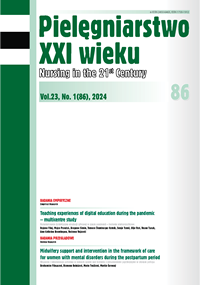Nursing care of a patient after a craniofacial area microsurgical transplant in a teenage boy
DOI:
https://doi.org/10.2478/pielxxiw-2024-0001Keywords:
nursing care, microsurgical transplantAbstract
NURSING CARE OF A PATIENT AFTER A CRANIOFACIAL AREA MICROSURGICAL TRANSPLANT IN A TEENAGE BOY
Aim. The aim of the study was to make selected nursing diagnoses for a patient after a microsurgical transplant in the facial area, with the aim of providing the patient with comprehensive care in the perioperative period.
Material and methods. The study describes the case of a child after microsurgical transplantation of a fl ap taken from the left iliac plate to the right submandibular region. The individual case method was used. Clinical interview, observation, measurement and medical documentation data were analyzed.
Results. Four selected nursing diagnoses were presented along with planned interventions: risk of complications at the site of microsurgical fl ap transplantation, risk of donor site infection, discomfort caused by intense oozing of secretions from the postoperative
wound in the oral cavity and the boy’s depressed mood caused by low self-esteem resulting from the changed postoperative facial appearance and the failure of the fi rst surgical procedure.
Conclusions. Nursing interventions should be adapted to the patient’s dynamically changing recovery process. They should be based on systematic inspection of the recipient and donor sites for the occurrence of complications. Education of the patient and the caregiver is an important element of the therapeutic process. It was not possible to signifi cantly improve the child’s mood.
References
1. Kobus K. Operacje rekonstrukcyjne w obrębie głowy i szyi. [w:] Kryst L, red. Chirurgia szczękowo-twarzowa. Warszawa: Wyd. PZWL; 2019, s. 551-614.
2. Kryst L. Onkologia szczękowo-twarzowa. [w:] Kryst L, red. Chirurgia szczękowo¬twarzowa. Warszawa: Wyd. PZWL; 2019, s. 417-447.
3. Jose D, Mendoza C, Roasa FV, et al. Pediatric free flap reconstruction for head and neck defects. Curr. Opin. Otolaryngol. Head Neck Surgery. 2018; 26(5): 334-339.
4. Sigaux N, Philouze P, Boucher F, et al. Efficacy of the postoperative management after microsurgical free tissue transfer. Journal of Stomatology, Oral and Maxillofacial Surgery. 2017; 118: 173-177.
5. Walewska E. Opieka nad chorym w okresie okołooperacyjnym. [w:] Ścisło L, red. Pielęgniarstwo chirurgiczne. Warszawa: Wyd. PZWL; 2020, s.174-216.
6. Moskal-Szybka M, Moskal A, Dziubaszewska R. Evidence-based nursing care of a patient treated with the Ilizarov method for lower limb length inequality. Piel. XXI w. 2023; 3(22): 214-220.
7. Ackley B. Ryzyko zachłyśnięcia. [w:] Ackley B, Ladwig G, red. Podręcznik diagnoz pielęgniarskich. Przewodnik planowania opieki opartej na dowodach naukowych. Warszawa: Wyd. GC Media House; 2011, s. 693-697.
8. Roman M, Franke E, Dowgierd K. Wybrane diagnozy i interwencje pielęgniarskie w przed- i pooperacyjnej opiece nad pacjentem po zabiegu ortognatycznym. Pielęgniarstwo Chirurgiczne i Angiologiczne. 2021; 4: 163-170.
9. Roman M. Wybrane diagnozy i interwencje pielęgniarskie u dzieci z wadami twarzowej części czaszki i jamy ustnej. [w:] Piskorz-Ogórek, Kaczmarski M, red. Pediatria i pielęgniarstwo pediatryczne. Wybrane zagadnienia. Kraków: Help-Med. TD;2023, s. 707-720.
10. Balicka N, Kobos E, Dziedzic B, Kryczka T. Oczekiwania personelu pielęgniarskiego w zakresie organizacji edukacji zdrowotnej dla pacjentów po przeszczepieniu nerki. Pielęgniarstwo Chirurgiczne i Angiologiczne. 2019; 3: 113-120.
11. Wrzostek Z, Pawik Ł. Psychologiczne aspekty leczenia nierównej długości kończyn dolnych. Medycyna Manualna. 2009; 13: 32-36.
Downloads
Published
Issue
Section
License
Copyright (c) 2024 Authors

This work is licensed under a Creative Commons Attribution 4.0 International License.




